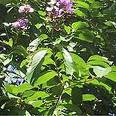The Banaba Tree or Pride of India has many other names including Queen’s Flower and Crape Myrtle. It is native to the Indian subcontinent where it grows wild and cultivated, and to the Philippines, South East Asia, Indonesia and Australia. It has been introduced into parts of tropical Africa, Jamaica and the USA. At the beginning of the year it starts to lose its leaves which have turned bright red or orange by that season. It can reach heights of up to 25 metres and is fast-growing (so is used as a nurse tree for slower growing saplings) with an extensive root system so is useful to stop soil erosion. It is also used as a living fence, and various items are made from its wood, including poles, decorative items and furniture. It is also used for construction and cut down for fuel by local people, who also use it for charcoal. Its bark produces a yellow dye too. However since its medicinal properties have been recognized by the West it is now an important medicinal plant and has been used for thousands of years in the Indian subcontinent as well as the Philippines and the rest of South East Asia to treat diabetes and low blood sugar levels.
 It contains corosolic acid, ellagitannins (in the fruit and leaves), triterpenoids, amino acids and flavonoids. Extensive studies of the leaves made in Japan confirmed the use of extracts from the leaves for diabetes. The corosolic acid lowers blood pressure and has insulin-like properties as do some of the amino acids, and this is what makes it so attractive to researchers. The leaves contain the minerals manganese and zinc among others, and it has been discovered that one of the side effects of banaba is very positive as it helps reduce weight and so banaba can be found in many weight control formulae in the US. Extracts obtained from the seeds (said to be narcotic) have powerful antioxidant properties and the ellagic acid compounds in banaba are being researched to discover if they can help in the treatment of HIV. Banaba may have antibiotic properties too. In fact it might provide a few “wonder drugs” after more research has been done into its properties and their effects on people. The whole plant can be used medicinally but not all parts have been researched as yet.
It contains corosolic acid, ellagitannins (in the fruit and leaves), triterpenoids, amino acids and flavonoids. Extensive studies of the leaves made in Japan confirmed the use of extracts from the leaves for diabetes. The corosolic acid lowers blood pressure and has insulin-like properties as do some of the amino acids, and this is what makes it so attractive to researchers. The leaves contain the minerals manganese and zinc among others, and it has been discovered that one of the side effects of banaba is very positive as it helps reduce weight and so banaba can be found in many weight control formulae in the US. Extracts obtained from the seeds (said to be narcotic) have powerful antioxidant properties and the ellagic acid compounds in banaba are being researched to discover if they can help in the treatment of HIV. Banaba may have antibiotic properties too. In fact it might provide a few “wonder drugs” after more research has been done into its properties and their effects on people. The whole plant can be used medicinally but not all parts have been researched as yet.BANABA LEAF TISANE
1 cup chopped banaba leaves
2 cups boiling water
Method
Boil the leaves in water for 30 mins.
Strain and drink.
This has Taste and is a Treat(ment).



